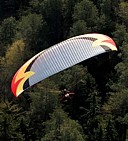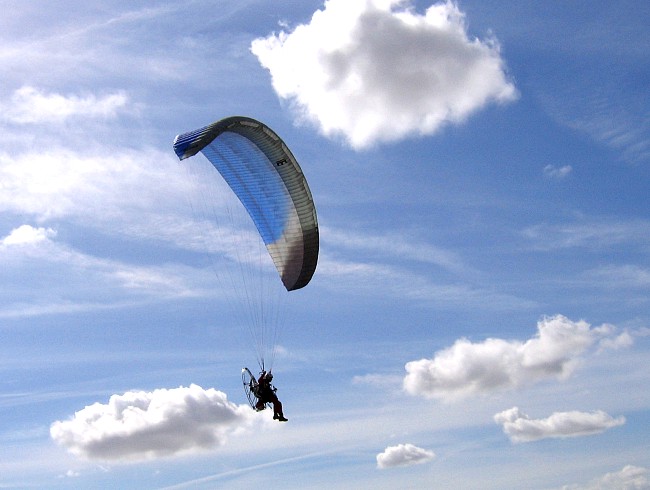Come and fly with us today !

|
Come and fly with us today ! |
 |
|
|
  |
 
|
|
||||||
|
name - size |
Plasma 25 |
Plasma 26.5 |
Plasma 28 |
Plasma 30 |
|
Certification |
- |
- |
- |
- |
|
Number of cells |
70 |
70 |
70 |
70 |
|
Surface area (flat) [m2] |
25,00 |
26,50 |
28,00 |
30,00 |
|
Surface area (projected) [m2] |
21,75 |
23,05 |
24,36 |
26,09 |
|
Span (flat) [m] |
12,14 |
12,50 |
12,85 |
13,30 |
|
Span (projected) [m] |
9,91 |
10,20 |
10,49 |
10,85 |
|
Aspect ratio (flat) |
5,90 |
|||
|
Aspect ratio (projected) |
4,52 |
|||
|
Sink rate [m/s] |
min = 1.0 ; trim = 1.2-1.8 ; max = 3.0 |
|||
|
Speed [km/h] |
min = 24 ; trim = 39-50 ; max = 67 |
|||
|
Max cord [cm] |
254 |
262 |
269 |
279 |
|
Minimum cord [cm] |
51,50 |
53,00 |
54,50 |
56,00 |
|
Distance pilot to wing [cm] |
808 |
832 |
855 |
885 |
|
Total lines lenght [m] |
457 |
471 |
484 |
502 |
|
Weight range * [kg] |
70 - 95 |
80 - 105 |
90 - 120 |
105 - 140 |
| Weight of the wing [kg] |
6.6 |
6.8 |
7.1 |
- |
|
Lines |
Technora (non-sheathed) 0,5 &
0,8 |
|||
|
Fabric |
SkyTex Evolution
45 g/m2 |
|||



|
||||||||




|
Size |
25 |
27 |
29 |
31 |
|
Certification AFNOR/CEN |
Performance |
Stand./Perform. |
Stand./Perform. |
Performance |
|
Number of cells |
65 |
65 |
65 |
65 |
|
Surface area (flat) [m2] |
25,77 |
27,81 |
29,80 |
31,92 |
|
Surface area (projected) [m2] |
22,82 |
24,63 |
26,39 |
28,27 |
|
Span (flat) [m] |
11,83 |
12,29 |
12,72 |
13,17 |
|
Span (projected) [m] |
9,82 |
10,20 |
10,56 |
10,93 |
|
Aspect ratio |
5,43/4,23 |
|||
|
Sink rate [m/s] |
min = 1,1; trim= 1,5-2; max = 3,1 |
|||
|
Speed [km/h] |
min = 23; trim = 42-46; max = 60 |
|||
|
Max cord [cm] |
267 |
277 |
287 |
297 |
|
Max wing depth [cm] |
50 |
52 |
54 |
56 |
|
Distance pilot to wing [cm] |
748 |
777 |
804 |
832 |
|
Total line lenght [m] |
397 |
411 |
427 |
442 |
|
Weight ranges * [kg] |
70-90 |
80-105 |
95-125 |
105-135 |
|
Weight of the wing [kg] |
6,8 |
7,1 |
7,5 |
7,8 |
|
Lines |
Technora 1,2 (or non-sheathed |
|||
|
Fabric |
SkyTex Aquatic 44
g/m2 (E85A) |
|||
|
||||||||||





|
Size |
25 |
27 |
29 |
31 |
34 |
|
Certification |
C* |
C* |
C* |
C* |
C* |
|
Number of cells |
50 |
50 |
50 |
50 |
50 |
|
Surface area (flat) [m2] |
25.00 |
27.00 |
29.00 |
31.00 |
34.00 |
|
Surface area (projected) [m2] |
21.46 |
23.17 |
24.89 |
26.61 |
29.18 |
|
Span (flat) [m] |
11.29 |
11.73 |
12.16 |
12.57 |
13.17 |
|
Span (projected) [m] |
9.01 |
9.36 |
9.70 |
10.03 |
10.50 |
|
Aspect ratio (flat) |
5.10 |
||||
|
Aspect ratio (projected) |
3.78 |
||||
|
Sink rate [m/s] |
min = 1.2; trim= 1.4-2.2; max = 3.5 |
||||
|
Speed [km/h] |
min = 23; trim = 37-49; max = 61 |
||||
|
Max cord [cm] |
273.91 |
284.65 |
295.00 |
305.00 |
319.43 |
|
Min cord [cm] |
60.35 |
62.72 |
65.00 |
67.20 |
70.38 |
|
Distance pilot to wing [cm] |
724.23 |
752.62 |
780.00 |
806.44 |
844.58 |
|
Total lines lenght [m] |
412.25 |
428.42 |
444.00 |
459.05 |
480.76 |
|
Weight range ** [kg] |
70-90 |
80-105 |
95-120 |
110-135 |
135-165 |
| Load test [kg] |
up to 175 |
up to 175 |
up to 175 |
up to 208 |
up to 208 |
| Weight of the wing [kg] |
5.7 |
6.7 |
7.2 |
7.6 |
8,2 |
|
Lines |
Technora 1.2 & 1.3 & 1.5 & 1.8 & 2.3 |
||||
|
Fabric |
SkyTex Evolution
45 g/m2 |
||||
|
Risers |
Pasamon - Bydgoszcz, Polska |
||||
|
||||||||||||||||||||||||||||||||||||||||||||||||||||||||||||||||||||||||||||||||